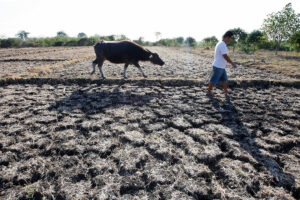El Niño peak during lean months for rice to show up in 2024 prices
RICE PRICES in early 2024 are likely to reflect the peak of the El Niño dry spell, which also coincides with the lean season for the staple grain, according to Calixto V. Chikiamco, president of the Foundation for Economic Freedom.

By Adrian H. Halili, Reporter
RICE PRICES in early 2024 are likely to reflect the peak of the El Niño dry spell, which also coincides with the lean season for the staple grain, according to Calixto V. Chikiamco, president of the Foundation for Economic Freedom.
Mr. Chikiamco said in a Viber message that the anticipated shortage needs to be headed off by building up inventory.
“If there isn’t a large stock of reserves that could cushion the supply pinch, rice prices could increase again,” Mr. Chikiamco said.
The government weather service, known as PAGASA (Philippine Atmospheric, Geophysical and Astronomical Services Administration), has forecast the peak of the El Niño to take place in late 2023 and early 2024.
A surge in the retail price of rice prompted President Ferdinand R. Marcos, Jr. to order price controls on Sept. 5. He fixed the maximum price at P41 per kilogram for regular-milled rice and P45 for well-milled rice.
Mr. Chikiamco said the price controls, which were lifted on Wednesday, were “not sustainable,” having caused traders to stop importing rice.
“The price ceiling caused traders to halt imports and therefore could have a short-term impact on rice supply. It also caused traders to reduce the price which they offered to farmers (for palay, or unmilled rice),” he said.
Former Agriculture Secretary William D. Dar said another round of price controls should not be resorted to the next time prices rise.
“Instead of re-imposing price caps, it is better to reduce the present tariff to only 10%. You can reduce rice prices significantly, but this should only be a temporary measure,” Mr. Dar said in a text message.
Mr. Marcos, who is also the Secretary of Agriculture, had rejected the proposal to temporarily lower the tariffs on imported rice, saying global rice prices are expected to fall.
Mr. Dar said that the government must continue to implement measures to stabilize rice prices.
“The government must see to it that there is big enough inventory in the hands of the households, commercial traders, and the National Food Authority (NFA),” Mr. Dar said.
As of early July, the national rice inventory fell 11.3% year on year to 1.8 million metric tons (MT), according to the Philippine Statistics Authority.
Inventory held by commercial establishments was at 984.76 thousand MT, households 771.93 thousand MT, and NFA warehouses 60.84 thousand MT.
“NFA must build up and increase its buffer stock by buying from local production,” Mr. Dar added.
The NFA Council last month set a new purchase rate for dry and wet palay of P19-P23 and P16-P19 per kilo, respectively. The previous buying price was P16 per kilo for wet and P19 per kilo for dry palay.













